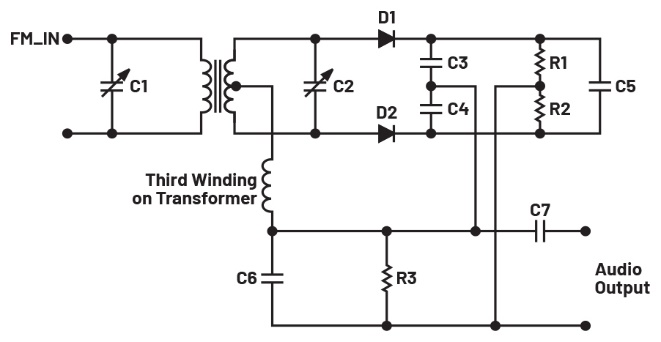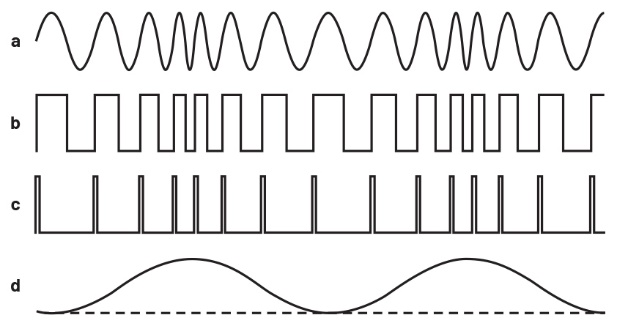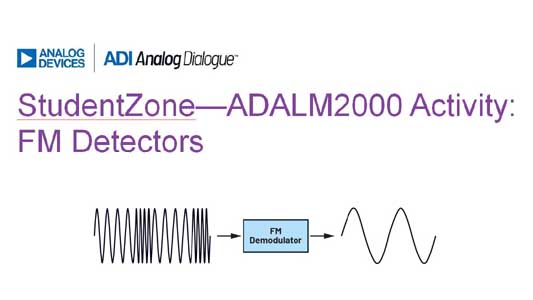Objective
The objective of this lab activity is to provide the basic principles of FM demodulation as well as the different circuits used to detect information from a received FM signal.
Background
For effective communication, both the sender and the receiver must agree on what communication channel to use. The sender then encodes the message and transmits it to the receiver. The receiver subsequently receives the message and decodes it. This process is similar in FM communication: the transmitted FM signal is received and must be demodulated to take the information.

FM detectors are circuits that instantaneously convert the frequency changes from the carrier signal to its output voltage counterpart. They are also known as frequency demodulators or discriminators. An FM detector’s transfer function is nonlinear. However, when operated in its linear range, the function is:

Where:
- VOUT = output voltage (information), V
- fINPUT = input FM signal, Hz
- Kd = transfer function, V/Hz
The input to the circuits is a frequency-varying signal with a constant amplitude. The circuits then transform these instantaneous frequency variations to amplitude variations. Thus, each voltage level in the output corresponds to its instantaneous frequency variation counterpart in the input. Therefore, the FM demodulator’s transfer function unit is in volts per hertz.
Just like AM, FM also has a modulation index. It is equal to the ratio of the frequency deviation to the modulating frequency. The frequency deviation is the amount of change or swing in carrier frequency produced by the modulating signal. FM’s modulation index is defined by:

Where:
- Delta f = frequency deviation
- fm = modulating frequency

Like AM, FM’s modulation index, m, is a measure of the peak frequency deviation. This is a way to express the peak deviation frequency as a multiple of the maximum modulating frequency. To illustrate this, refer to Figure 2.
The carrier signal frequency is 1 kHz, the modulating frequency 100 Hz, and the modulation index is 3. Taking note of the modulation index, this makes the peak frequency deviation 300 Hz. The frequency will swing between 700 Hz and 1300 Hz. Alternatively, the role of the modulating frequency is to determine the speed at which the cycle completes.
There are different types of FM demodulators including:
- Slope detectors
- Foster-Seeley discriminators
- Ratio detectors
- Pulse-averaging discriminators
- Quadrature detectors
- Phase-locked loops
For the sake of simplicity, we will dive into the slope detector to understand the basic function of an FM demodulator.
Slope Detector
The slope detector, otherwise known as a single-ended slope detector, is the simplest form of an FM demodulator. It is a tuned-circuit frequency demodulator type wherein it converts FM signals to AM using tuned (LC) circuits and extract the information from the AM envelope using a series connection of a diode and a capacitor (conventional peak detector.) It can be used with any radio even if it does not have FM capability. The slope detector relies on the selectivity of the receiver and its circuit operation is basic to all tuned-circuit discriminators. It is composed of a tuned circuit and a diode peak detector—the basic components of a typical tuned-circuit frequency discriminator. Figures 3 and 4 show the traditional and simplified schematic diagram.


Despite its simplicity, the slope detector has the most nonlinear voltage vs. frequency characteristics—thus, it is rarely used.
Figure 5 illustrates its voltage vs. frequency characteristic.

Another variation of a slope detector is a balanced slope detector. It is composed of two single-ended slope detectors connected in parallel and fed 180° out of phase.
Procedure
Open the simulation file (circuit in Figure 6). In the circuit, an FM signal with a 1 kHz modulating frequency, 5 V to 20 kHz carrier signal, and a modulating index of 5 is fed to the input. The tuned circuit formed by C1 and L1 performs the FM-to-AM conversion and the peak detector formed by D1, R2, and C2 extract the information from the AM envelope. Run the simulation file and observe the waveforms.


The waveforms observed should be similar to that of Figure 7.
Other Circuits
Foster-Seeley Discriminator and Ratio Detectors
The Foster-Seeley discriminator and ratio detector were widely used FM demodulators for radio receivers that typically used discrete components. Figure 8 shows a Foster-Seeley discriminator schematic and Figure 9 shows a ratio detector. At first look, the two circuits are similar. They both have an RF transformer and a pair of diodes, but unlike the ratio detector, the Foster-Seeley has no third winding. Instead, it has a choke.


Both demodulators are simple to construct using discrete components and offer high performance and linearity. However, the Foster-Seeley provides a higher output and lower distortion than the ratio detector, and the ratio detector boasts superior immunity to amplitude noise and a wider bandwidth compared to the Foster-Seeley. The downsides to these demodulators include the high cost of their transformers and the challenges to incorporate them with an integrated circuit, leading to their limited use today.
Pulse-Averaging Discriminators
A pulse-averaging discriminator uses a zero-crossing detector, a one-shot multivibrator, and a low-pass filter to recover the original modulating signal. Figure 10 shows a block diagram of the pulse-averaging discriminator. Figure 11 shows the waveforms.

This is a very high quality frequency demodulator and was limited to expensive telemetry and industrial control applications. But due to the availability of low cost ICs, the pulse-averaging discriminator is easily implemented and is now used in many electronic products.

Quadrature Detectors

The quadrature detector (Figure 12) is probably the single most widely used FM demodulator. It uses a phase-shift circuit to produce a phase shift of 90° at the unmodulated carrier frequency. This detector is primarily used in TV demodulation and is used in some FM radio stations.
Phase-Locked Loops
The phase-locked loop (PLL) is a frequency- or phase-sensitive feedback control circuit. All PLLs have three basic elements: a phase detector, low-pass filter, and voltage-controlled oscillator. PLLs are used in frequency demodulation, frequency synthesizers, and various filtering and signal detection applications. Figure 13 shows the block diagram of a PLL.

A phase-locked loop used as an FM demodulator (though the operation of a PLL is involved) is probably the simplest and easiest to understand. The ability of a phase-locked loop to provide frequency selectivity and filtering gives it a signal-to noise ratio superior to that of any other type of FM detector. For a more in-depth study of its operation, check the lab activity “The Phase-Locked Loop.”
Question
In the slope detector, what happens to the output signal if C2 is changed to 0.001 μF? 0.1 μF?
You can find the answer at the StudentZone blog.
About the Author
Antoniu Miclaus is a software engineer at Analog Devices, where he works on embedded software for Linux and no-OS drivers, as well as ADI academic programs, QA automation, and process management. He started working at ADI in February 2017 in Cluj-Napoca, Romania. He holds an M.Sc. degree in software engineering from the Babes-Bolyai University and a B.Eng. degree in electronics and telecommunications from the Technical University of Cluj-Napoca.














